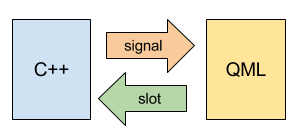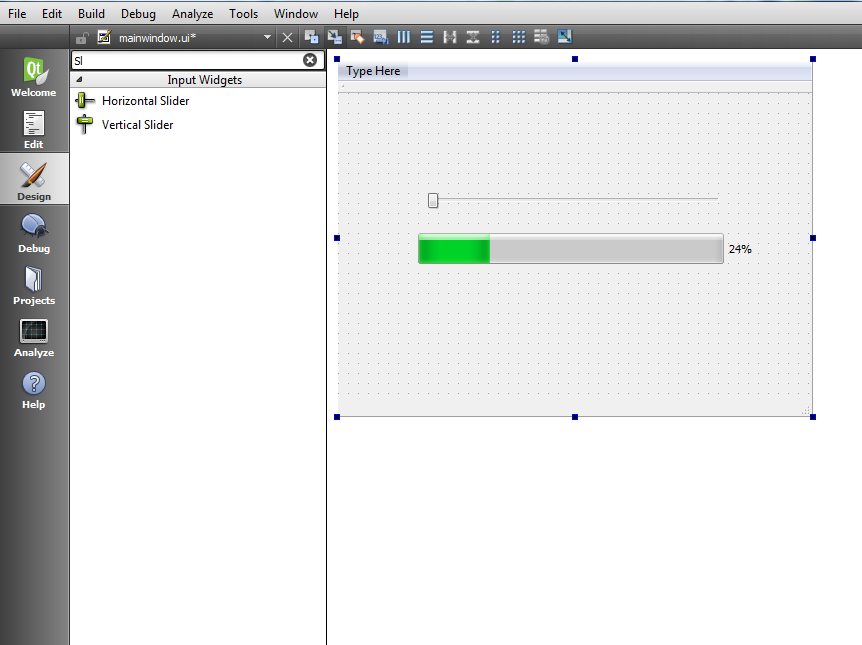- PyQt Tutorial
- PyQt Useful Resources
- Selected Reading
Emitting a signal from QML and listening to it from C. To create a signal in QML, simply add the following line to the object which will emit the signal. Signal submitTextField(string text) Here I have created a signal, submitTextField, which will pass a string as an argument to any connecting slots (if they choose to receive it). For our signal and slot example, we will handle two types of widgets such as LineEdit and Label. Under the input widgets, choose “QLineEdit” and drag and drop to the Dialog form. In the same way, click a Qlabel from the Display widgets drag and drop to the Dialog form. While being better in many regards, the new connection syntax in Qt5 has one big weakness: Connecting overloaded signals and slots. In order to let the compiler resolve the overloads we need to use staticcasts to member function pointers, or (starting in Qt 5.7) qOverload and friends. Corresponding signal and slot arguments must have the same types, so for example, we could not connect a QDial's valueChanged(int) signal to a QLineEdit's setText(QString) slot. In our dial and spinbox example we used the instance.methodName syntax as we did with the example applications shown earlier in the chapter.
Unlike a console mode application, which is executed in a sequential manner, a GUI based application is event driven. Functions or methods are executed in response to user’s actions like clicking on a button, selecting an item from a collection or a mouse click etc., called events.
Widgets used to build the GUI interface act as the source of such events. Each PyQt widget, which is derived from QObject class, is designed to emit ‘signal’ in response to one or more events. The signal on its own does not perform any action. Instead, it is ‘connected’ to a ‘slot’. The slot can be any callable Python function.
In PyQt, connection between a signal and a slot can be achieved in different ways. Following are most commonly used techniques −
A more convenient way to call a slot_function, when a signal is emitted by a widget is as follows −
Suppose if a function is to be called when a button is clicked. Here, the clicked signal is to be connected to a callable function. It can be achieved in any of the following two techniques −
or
Example
In the following example, two QPushButton objects (b1 and b2) are added in QDialog window. We want to call functions b1_clicked() and b2_clicked() on clicking b1 and b2 respectively.
When b1 is clicked, the clicked() signal is connected to b1_clicked() function
When b2 is clicked, the clicked() signal is connected to b2_clicked() function
Example
The above code produces the following output −
Output
Description:Signals are software interrupts delivered to a process by the operating system.Signals can also be issued by the operating system based on system or error conditions.There is a default behavior for some (i.e. a process is terminated when it receives an inturrupt SIGINT signal by pressing keystrokes ctrl-C) but this tutorial shows how to handle the signal by defining callback functions to manage the signal. Where possible, this allows one to close files and perform operations and react in a manner defined by the programmer.
Note that not all signals can be handled.
Types of signals:
| Signal | Value | Description |
|---|---|---|
| SIGHUP | 1 | Hangup (POSIX) Report that user's terminal is disconnected. Signal used to report the termination of the controlling process. |
| SIGINT | 2 | Interrupt (ANSI) Program interrupt. (ctrl-c) |
| SIGQUIT | 3 | Quit (POSIX) Terminate process and generate core dump. |
| SIGILL | 4 | Illegal Instruction (ANSI) Generally indicates that the executable file is corrupted or use of data where a pointer to a function was expected. |
| SIGTRAP | 5 | Trace trap (POSIX) |
| SIGABRT SIGIOT | 6 | Abort (ANSI) IOT trap (4.2 BSD) Process detects error and reports by calling abort |
| SIGBUS | 7 | BUS error (4.2 BSD) Indicates an access to an invalid address. |
| SIGFPE | 8 | Floating-Point arithmetic Exception (ANSI). This includes division by zero and overflow.The IEEE Standard for Binary Floating-Point Arithmetic (ANSI/IEEE Std 754-1985) defines various floating-point exceptions. |
| SIGKILL | 9 | Kill, unblockable (POSIX) Cause immediate program termination. Can not be handled, blocked or ignored. |
| SIGUSR1 | 10 | User-defined signal 1 |
| SIGSEGV | 11 | Segmentation Violation (ANSI) Occurs when a program tries to read or write outside the memory that is allocated for it by the operating system, dereferencing a bad or NULL pointer. Indicates an invalid access to valid memory. |
| SIGUSR2 | 12 | User-defined signal 2 |
| SIGPIPE | 13 | Broken pipe (POSIX) Error condition like trying to write to a socket which is not connected. |
| SIGALRM | 14 | Alarm clock (POSIX) Indicates expiration of a timer. Used by the alarm() function. |
| SIGTERM | 15 | Termination (ANSI) This signal can be blocked, handled, and ignored. Generated by 'kill' command. |
| SIGSTKFLT | 16 | Stack fault |
| SIGCHLD SIGCLD | 17 | Child status has changed (POSIX) Signal sent to parent process whenever one of its child processes terminates or stops. See the YoLinux.com Fork, exec, wait, waitpid tutorial |
| SIGCONT | 18 | Continue (POSIX) Signal sent to process to make it continue. |
| SIGSTOP | 19 | Stop, unblockable (POSIX) Stop a process. This signal cannot be handled, ignored, or blocked. |
| SIGTSTP | 20 | Keyboard stop (POSIX) Interactive stop signal. This signal can be handled and ignored. (ctrl-z) |
| SIGTTIN | 21 | Background read from tty (POSIX) |
| SIGTTOU | 22 | Background write to tty (POSIX) |
| SIGURG | 23 | Urgent condition on socket (4.2 BSD) Signal sent when 'urgent' or out-of-band data arrives on a socket. |
| SIGXCPU | 24 | CPU limit exceeded (4.2 BSD) |
| SIGXFSZ | 25 | File size limit exceeded (4.2 BSD) |
| SIGVTALRM | 26 | Virtual Time Alarm (4.2 BSD) Indicates expiration of a timer. |
| SIGPROF | 27 | Profiling alarm clock (4.2 BSD) Indicates expiration of a timer. Use for code profiling facilities. |
| SIGWINCH | 28 | Window size change (4.3 BSD, Sun) |
| SIGIO SIGPOLL | 29 | I/O now possible (4.2 BSD) Pollable event occurred (System V) Signal sent when file descriptor is ready to perform I/O (generated by sockets) |
| SIGPWR | 30 | Power failure restart (System V) |
| SIGSYS | 31 | Bad system call |
Signals which can be processed include: SIGINT, SIGABRT, SIGFPE, SIGILL, SIGSEGV, SIGTERM, SIGHUP
List all signals available to the system:
Use the command: kill -lSending a process a signal:
A process can be sent a signal using the 'kill' command: kill -s signal-numberpidWhere the pid (process id) can be obtained using the 'ps' command.
Basic C signal callback function example:
File: signalExample.cpp
 Example to handle ctrl-c
Example to handle ctrl-cCompile: gcc signalExample.cpp
 Run: a.out
Run: a.outResults:
The function prototype: void (*signal (int sig, void (*func)(int)))(int);
Qt Signal Slot Example C
- signal - ANSI C signal handling
- raise - send a signal to the current process
- strsignal - return string describing signal (GNU extension)
- psignal - print signal message
- sigaction - POSIX signal handling functions
- sigsetops - POSIX signal set operations
- sigvec - BSD software signal facilities
- alarm - set an alarm clock for delivery of a signal
- kill - terminate a process
- ps - report a snapshot of the current processes.
Example Slot Signal C++ Jammer
| C++ How to Program by Harvey M. Deitel, Paul J. Deitel ISBN #0131857576, Prentice Hall Fifth edition. The first edition of this book (and Professor Sheely at UTA) taught me to program C++. It is complete and covers all the nuances of the C++ language. It also has good code examples. Good for both learning and reference. | |
| 'Advanced UNIX Programming' Second Edition by Marc J. Rochkind ISBN # 0131411543, Addison-Wesley Professional Computing Series | |
| 'Advanced Programming in the UNIX Environment' First Edition by W. Richard Stevens ISBN # 0201563177, Addison-Wesley Professional Computing Series It is the C programmers guide to programming on the UNIX platform. This book is a must for any serious UNIX/Linux programmer. It covers all of the essential UNIX/Linux API's and techniques. This book starts where the basic C programming book leaves off. Great example code. This book travels with me to every job I go to. | |
| 'UNIX Network Programming, Volume 1: Networking APIs - Sockets and XTI' Second Edition by W. Richard Stevens ISBN # 013490012X, Prentice Hall PTR This book covers network APIs, sockets + XTI,multicast, UDP, TCP, ICMP, raw sockets, SNMP, MBONE. In depth coverageof topics. | |
| 'UNIX Network Programming Volume 2: Interprocess Communications' by W. Richard Stevens ISBN # 0130810819, Prentice Hall PTR This book covers semaphores, threads, record locking, memory mapped I/O, message queues, RPC's, etc. | |
| 'Advanced Unix Programming' by Warren W. Gay ISBN # 067231990X, Sams White Book Series This book covers all topics in general: files,directories, date/time, libraries, pipes, IPC, semaphores, sharedmemory, forked processes and I/O scheduling. The coverage is not as indepth as the previous two books (Stevens Vol 1 and 2) |
Qt Signal Slot Example C++
